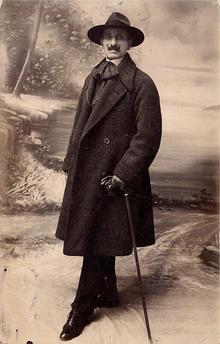Tawfiq Tarek
Tawfiq Tarek (also Tawfik Tarek , * 1877 in Damascus , † 1940 in Beirut ) was a Syrian painter and architect .
biography
Tawfik is considered an important artist on the Syrian art scene of his time. He was an avant-garde in his art and his thinking.
He was born in Damascus in 1877 to a wealthy family. When Tawfik was ten years old, his father died. His mother's wealth enabled him to study architecture at the École des Beaux Arts in Paris . Here he experienced the French art scene, which had a lasting impact on him. After completing his studies, he returned to Damascus in 1905 and worked there as an architect and painter. He restored a number of mosques and important historical buildings, including the minarets and mosaics of the Omayyad Mosque . He was friends with important Syrian personalities, including Abd al-Rahman Pasha al Yusef, the then Amir al-Haj and the then Syrian President Sheikh Taj Al-Hassani .
In the first World War
Tawfiq Tarek served as an officer in the Ottoman army. In 1917 he was taken prisoner by the British in Palestine. However, he managed to escape through a trick: During a tour with British officers through the old town of Damascus, he entered the Omayyad mosque in front of the officers and, due to their ignorance that it had several entrances and exits, he reached another gate unmolested fled the side of the Omayyad Mosque and he disappeared into the crowd.
About Tawfik's art
The motifs of his pictures were Damascus and its surroundings as well as historical buildings, for example the Omayyad Mosque and the Damascus old town. Tawfik also painted portraits of personalities of his time, such as the portrait of Sheikh Taher al-Jazaeri. His historical images are of great importance to Arab history.
Selected works of art are:
- The Battle of Huttin (painted 1940 in Beirut), the picture hangs today in the reception hall of the Syrian presidential palace in Damascus.
- Saida burns (painted in Beirut in 1938), privately owned, the picture depicts the attack of the Roman army on Saida in 350 AD. It was planned for the 1938/39 World Exhibition in New York. * Portrait of the Grand Mufti of Damascus Sheikh Badr ad-din Al-Hassani, the work is owned by the Al-Hassani family.
Tawfiq Tarek was an intellectual personality and had a strong knowledge of many different fields besides art and architecture, such as astronomy, history, politics. He spoke several languages fluently. He preferred classical painting in and is considered a pioneer of the Syrian art scene and a role model for subsequent generations of Syrian artists. Above all, his pictures show the Arab-Syrian atmosphere of the country; they are very vividly detailed.
When the country fell under the French mandate in 1925, he left Damascus and went to Beirut. Here he was able to establish himself in Beirut society and painted commissioned works until his death. He was able to expand his influence here through several trips to Palestine. He was close friends with the Abu al-Huda family, who owned many of his paintings. In 1940 he painted his last picture, The Battle of Huttin . He died in Beirut that same year and was buried in Damascus.
With the establishment of the State of Israel in 1948, many of his pictures were lost while the Al-Huda family fled.
Web links
- Interview with Tarek Tawfik on youtube.com on October 29, 2014 (English; 2:20 minutes)
Individual evidence
- ↑ Charlotte Bank: Lecture in the German-Arab Friendship Society (DAFG): Modern Artistic Practice in the Arab World , May 8, 2018, accessed on August 22, 2020.
| personal data | |
|---|---|
| SURNAME | Tarek, Tawfiq |
| ALTERNATIVE NAMES | Tarek, Tawfik |
| BRIEF DESCRIPTION | Syrian painter and architect |
| DATE OF BIRTH | 1877 |
| PLACE OF BIRTH | Damascus , Syria |
| DATE OF DEATH | 1940 |
| Place of death | Beirut |



